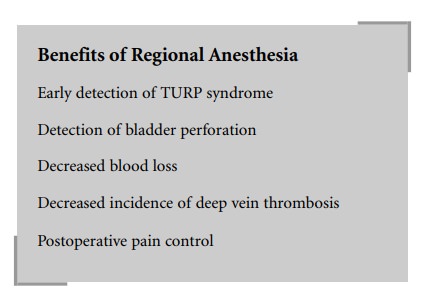Chapter: Clinical Cases in Anesthesia : Transurethral Resection of the Prostate
What are the anesthetic options for a patient under-going a TURP?
What are
the anesthetic options for a patient under-going a TURP?
Regional anesthesia has long been considered
the anes-thetic of choice for this procedure. The clear advantage of this
technique is the ability to monitor for the early signs of hyponatremia such as
irritability and headache. If these occur, a serum Na+ level should
be checked and hypona-tremia, if confirmed, should be treated expeditiously. It
is important to remember that the development of combat-iveness
intraoperatively should not be assumed to be inadequate anesthesia. Deepening
the anesthetic level with sedation could have a catastrophic effect.
As discussed earlier, another potentially fatal
complica-tion of a TURP is bladder perforation. If a T10 level of
sen-sory blockade is achieved, the patient would still be able to complain of
abdominal or shoulder pain. This complaint would alert the anesthesiologist and
the surgeon to the probability of a bladder perforation, and would allow for
prompt diagnosis and treatment.
As with other pelvic procedures, regional
anesthesia has been shown to decrease blood loss and the incidence of deep vein
thrombosis. The decrease in blood loss is most likely secondary to the decrease
in blood pressure as well as the decrease in both central and peripheral venous
pressure associated with neuraxial anesthesia. A number of different reasons
have been postulated for the decreased incidence of deep vein thromboses. One
reason may be the increase in peripheral blood flow resulting from the
sympathetic blockade. Other reasons include an increase in prothrombin time, a
measure of the extrinsic pathway of coagulation, and a decrease in platelet
count.
Another clear advantage of regional anesthesia
is post-operative pain control. Good postoperative pain control will also allow
the patient to avoid the sympathetic response to pain, such as tachycardia and
hypertension, which could increase the likelihood of myocardial ischemia in
susceptible patients.

The presence of comorbid condition(s) in the
patient may necessitate a general anesthetic. It must be appreciated that the
early neurologic signs and symptoms associated with hyponatremia,
hypo-osmolality or bladder perforation will no longer be available to the
anesthesiologist. When a general anesthetic is chosen, a smooth emergence is
desirable. If the patient awakens coughing and “bucking” on the endotracheal
tube, venous pressure will increase and bleeding may develop.
Related Topics